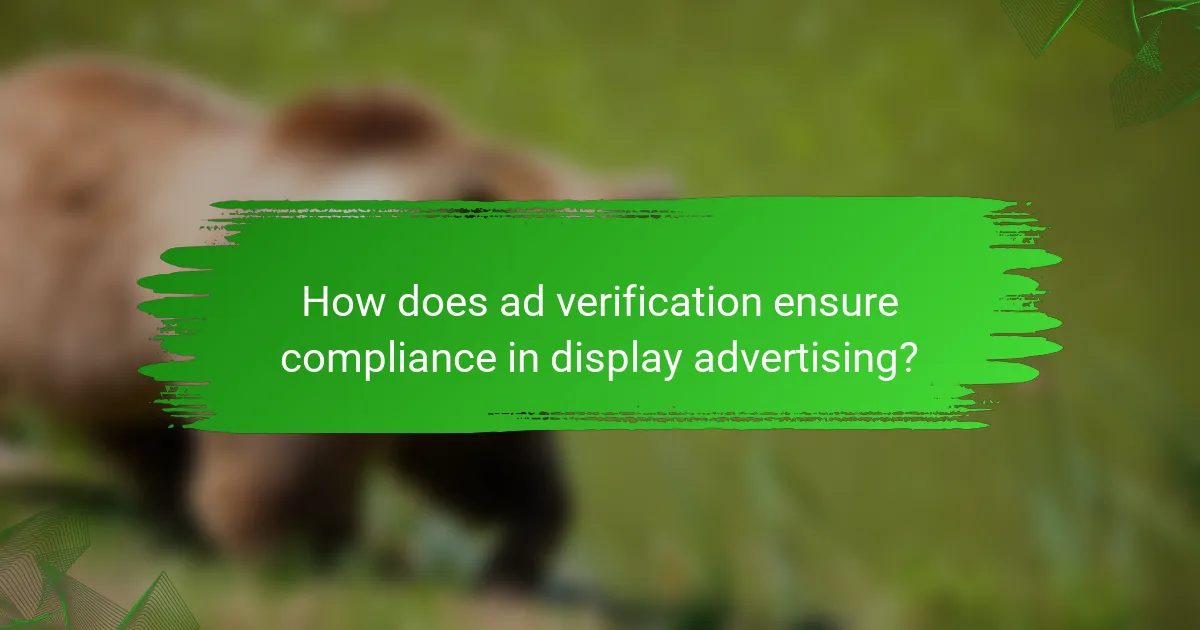Ad verification is essential for maintaining compliance in display advertising by ensuring that ad placements adhere to established standards and regulations. By monitoring key factors such as viewability and brand safety, these tools not only enhance trust between advertisers and consumers but also improve campaign performance and reduce ad fraud.

How does ad verification ensure compliance in display advertising?
Ad verification plays a crucial role in ensuring compliance in display advertising by monitoring and validating ad placements against established standards and regulations. This process helps maintain transparency, protects brand integrity, and fosters trust between advertisers and consumers.
Regulatory adherence
Regulatory adherence in ad verification involves ensuring that advertisements comply with local laws and industry standards. This includes following guidelines set by organizations like the Interactive Advertising Bureau (IAB) and adhering to privacy regulations such as the General Data Protection Regulation (GDPR) in Europe.
Advertisers should regularly review their campaigns to ensure they meet these regulations. Non-compliance can lead to penalties, including fines and reputational damage, making it essential to integrate compliance checks into the ad verification process.
Brand safety measures
Brand safety measures are designed to protect a brand’s reputation by ensuring that ads do not appear alongside inappropriate or harmful content. Ad verification tools assess the context of ad placements, filtering out sites that host offensive material or misinformation.
To enhance brand safety, advertisers should utilize whitelists and blacklists, which specify acceptable and unacceptable sites for ad placements. Regular audits of ad placements can help identify potential risks and ensure that brand safety standards are consistently met.
Fraud detection mechanisms
Fraud detection mechanisms in ad verification focus on identifying and preventing fraudulent activities, such as click fraud and impression fraud. These mechanisms utilize algorithms and machine learning to analyze traffic patterns and detect anomalies that may indicate fraudulent behavior.
Advertisers should implement robust fraud detection tools that provide real-time monitoring and reporting. Regularly reviewing campaign performance metrics can help identify suspicious activity and mitigate losses associated with ad fraud.

What are the key benefits of ad verification?
Ad verification offers significant advantages, including enhanced trust, improved campaign performance, and a reduction in ad fraud. These benefits help ensure that advertising efforts are effective and reliable, fostering a better environment for both advertisers and consumers.
Enhanced trust with advertisers
Ad verification builds trust between publishers and advertisers by ensuring that ads are displayed in safe and appropriate environments. When advertisers know their ads are being monitored for compliance and quality, they are more likely to invest in campaigns.
For instance, using verification tools can confirm that ads are not placed alongside inappropriate content, which reassures advertisers about their brand’s safety. This trust can lead to longer-term partnerships and increased ad spend.
Improved campaign performance
Effective ad verification can lead to better campaign performance by ensuring that ads reach the intended audience in the right context. By verifying placements, advertisers can optimize their targeting strategies and increase engagement rates.
For example, campaigns that utilize verification data can adjust their placements based on performance metrics, leading to higher click-through rates and conversions. This proactive approach helps maximize return on investment (ROI).
Reduction of ad fraud
Ad verification plays a crucial role in reducing ad fraud, which can significantly impact advertising budgets. By employing verification technologies, advertisers can detect and prevent fraudulent activities such as click fraud and impression fraud.
Implementing verification measures can help identify suspicious traffic patterns and block non-human interactions. This not only protects financial resources but also ensures that advertising efforts are directed towards genuine audiences, enhancing overall campaign integrity.

What tools are available for ad verification?
Ad verification tools help ensure that digital advertisements meet compliance standards, maintain quality, and build trust with consumers. These tools assess various aspects such as viewability, brand safety, and fraud detection, providing advertisers and publishers with essential insights.
DoubleVerify
DoubleVerify is a leading ad verification platform that focuses on ensuring the quality and effectiveness of digital advertising. It offers services such as brand safety, fraud detection, and viewability measurement, helping advertisers confirm that their ads are seen by real users in safe environments.
One key feature of DoubleVerify is its ability to provide real-time reporting, allowing advertisers to make immediate adjustments to their campaigns. Additionally, it integrates with various ad platforms, making it a versatile choice for many marketers.
Integral Ad Science
Integral Ad Science (IAS) specializes in measuring and optimizing the quality of digital ads. Its tools assess brand safety, ad fraud, and viewability, ensuring that ads are displayed in appropriate contexts and reach their intended audiences.
IAS uses advanced algorithms and machine learning to analyze ad placements and performance. Advertisers can leverage these insights to improve campaign effectiveness and reduce wasted ad spend, which can be particularly beneficial in competitive markets.
Moat by Oracle
Moat, a product by Oracle, provides comprehensive analytics for digital advertising, focusing on viewability and engagement metrics. It helps advertisers understand how their ads perform across different platforms and formats, ensuring that they achieve maximum impact.
Moat’s unique features include attention metrics that gauge consumer engagement with ads. This data can guide advertisers in refining their strategies and optimizing their creative content for better results.

How to choose the right ad verification solution?
Choosing the right ad verification solution requires careful consideration of various factors, including effectiveness, cost, and integration with existing systems. A well-selected solution enhances compliance, builds trust, and ensures quality control in advertising efforts.
Criteria for selection
When selecting an ad verification solution, prioritize features such as fraud detection, viewability measurement, and brand safety. Look for solutions that comply with industry standards like the Interactive Advertising Bureau (IAB) guidelines to ensure reliability.
Additionally, consider the reputation of the provider and their track record in the market. Reviews and case studies can provide insights into their effectiveness and customer satisfaction.
Cost considerations
Cost is a critical factor when choosing an ad verification solution. Solutions can range from low-cost options to premium services, often depending on the features offered. Evaluate your budget and determine which features are essential for your needs.
Keep in mind that some providers charge based on the volume of ads verified, while others may have a flat fee. Assess the potential return on investment by considering how much you could save from reduced fraud and improved ad performance.
Integration capabilities
Integration capabilities are essential for seamless operation. Ensure that the ad verification solution can easily integrate with your existing ad tech stack, including demand-side platforms (DSPs) and ad servers. This will streamline your workflow and enhance data sharing.
Check if the solution offers APIs or plugins that facilitate integration. A solution that works well with your current systems can save time and reduce the complexity of managing multiple tools.

What are the challenges in ad verification?
Ad verification faces several challenges that can hinder its effectiveness, including data privacy concerns, technological limitations, and market fragmentation. These issues can complicate the process of ensuring compliance, building trust, and maintaining quality control in advertising.
Data privacy concerns
Data privacy is a significant challenge in ad verification, as regulations like GDPR in Europe and CCPA in California impose strict guidelines on how personal data can be collected and used. Advertisers must navigate these laws carefully to avoid hefty fines and maintain consumer trust.
To address privacy issues, companies should implement transparent data practices and obtain explicit consent from users. This can include clear privacy policies and options for users to opt-out of data collection.
Technological limitations
Technological limitations can hinder the effectiveness of ad verification tools. Many existing solutions may struggle to keep up with the rapid pace of digital advertising, leading to gaps in verification processes. For example, real-time verification may not always be feasible, resulting in delayed insights.
Investing in advanced technologies, such as machine learning and artificial intelligence, can enhance verification capabilities. These technologies can help automate processes and improve accuracy, allowing for better detection of fraudulent activities.
Market fragmentation
Market fragmentation presents a challenge in ad verification, as the advertising ecosystem consists of numerous platforms, formats, and stakeholders. This diversity can lead to inconsistencies in verification standards and practices across different channels.
To combat fragmentation, advertisers should adopt standardized verification metrics and collaborate with industry partners to establish common guidelines. This approach can help streamline processes and ensure a more cohesive verification strategy across various platforms.

How does ad verification impact consumer trust?
Ad verification significantly enhances consumer trust by ensuring that advertisements are displayed accurately and responsibly. When consumers know that ads are being monitored for compliance and quality, they feel more secure in their interactions with brands.
Transparency in advertising
Transparency in advertising is crucial for building consumer confidence. Ad verification provides insights into where and how ads are displayed, allowing consumers to see the integrity behind the marketing messages. For example, when brands disclose their ad placements and the verification processes they use, it fosters a sense of openness.
Moreover, clear reporting on ad performance and compliance helps consumers understand the value of the ads they encounter. This transparency can lead to higher engagement rates and a more positive perception of the brand.
Accountability for brands
Accountability is a key aspect of ad verification that holds brands responsible for their advertising practices. When brands know they are being monitored, they are more likely to adhere to ethical standards and regulations. This accountability can prevent misleading advertisements and ensure that consumers receive truthful information.
Additionally, brands that prioritize ad verification can demonstrate their commitment to quality and integrity, which can differentiate them in a competitive market. By actively engaging in verification processes, brands can mitigate risks associated with ad fraud and enhance their reputation among consumers.







